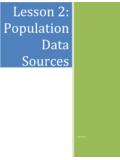Transcription of HANDBOOK - Tradingportalen.com
1 TheTechnical AnalysisH A N D B O O KULTIMATEE lliott Wave International eCourse BookThe Ultimate technical analysis HandbookExcerpted from The Traders Classroom collection Volumes 1-4 eBooksBy Jeffrey Kennedy, Elliott Wave InternationalChapter 1 How the Wave Principle Can Improve Your Trading July 2005 ..page 3 chapter 2 How To Confirm You Have the Right Wave Count October 2005 .. page 6 chapter 3 How To Integrate technical Indicators Into an Elliott Wave Forecast 1 . How One technical Indicator Can Identify Three Trade Setups October 2004.
2 Page 8 2. How To Use technical Indicators To C onfirm Elliott Wave Counts November 2004 ..page 13 3 . How Moving Averages Can Alert You to Future Price Expansion December 2004 .. page 17 chapter 4 Origins and Applications of the Fibonacci Sequence 1 . How To Identify Fibonacci Retracements June 2003 ..page 19 2 . How To Calculate Fibonacci Projections July 2003 .. page 21 chapter 5 How To Apply Fibonacci Math to Real-World Trading August 2005 .. page 26 chapter 6 How To Draw and Use Trendlines 1.
3 The Basics: How a Kid With a Ruler Can Make a Million April 2004 ..page 32 2. How To Use Elliott s Channeling Technique May 2004 .. page 37 3. How To Use Jeffrey Kennedy s Channeling Technique June 2004 .. page 40 chapter 7 Time Divergence: An Old Method Revisited March 2007 ..page 45 chapter 8 Head and Shoulders: An Old-School Approach December 2007 ..page 47 chapter 9 Pick Your And Your Protective Stops: Four Kinds of Protective Stops July 2006 ..page 50 Editor s Note: This eBook includes hand-picked lessons from more than 200 pages of EWI s comprehensive Trader s Classroom collection of eBooks.
4 Learn more here: 1 How the Wave Principle Can Improve Your Trading Every trader, every analyst and every technician has favorite techniques to use when trading. But where tra-ditional technical studies fall short, the Wave Principle kicks in to show high probability price targets. Just as important, it can distinguish high probability trade setups from the ones that traders should technical Studies Fall ShortThere are three categories of technical studies: trend-following indicators, oscillators and sentiment indicators.
5 Trend-following indicators include moving averages, Moving Average Convergence-Divergence (MACD) and Directional Movement Index (ADX). A few of the more popular oscillators many traders use today are Stochastics, Rate-of-Change and the Commodity Channel Index (CCI). Sentiment indicators include Put-Call ratios and Commitment of Traders report studies like these do a good job of illuminating the way for traders, yet they each fall short for one major reason: they limit the scope of a trader s understanding of current price action and how it relates to the overall picture of a market.
6 For example, let s say the MACD reading in XYZ stock is positive, indicating the trend is up. That s useful information, but wouldn t it be more useful if it could also help to answer these questions: Is this a new trend or an old trend? If the trend is up, how far will it go? Most technical studies simply don t reveal pertinent information such as the maturity of a trend and a definable price target but the Wave Principle Does the Wave Principle Improve Trading?Here are five ways the Wave Principle improves trading: 1.
7 Identifies TrendThe Wave Principle identifies the direction of the dominant trend. A five-wave advance identifies the overall trend as up. Conversely, a five-wave decline determines that the larger trend is down. Why is this information important? Because it is easier to trade in the direction of the dominant trend, since it is the path of least resistance and undoubtedly explains the saying, the trend is your friend. Simply put, the probability of a successful commodity trade is much greater if a trader is long Soybeans when the other grains are Identifies CountertrendThe Wave Principle also identifies countertrend moves.
8 The three-wave pattern is a corrective response to the preceding impulse wave. Knowing that a recent move in price is merely a correction within a larger trending market is especially important for traders, because corrections are opportunities for traders to position themselves in the direction of the larger trend of a Ultimate technical analysis HANDBOOK 2009 Elliott Wave InternationalThis ebook includes handpicked lessons from more than 200 pages of EWI s comprehensive Trader s Classroom collection of eBooks.
9 Learn more here: Determines Maturity of a TrendAs Elliott observed, wave patterns form larger and smaller versions of them-selves. This repetition in form means that price activity is fractal, as illustrated in Figure 1. Wave (1) subdivides into five small waves, yet is part of a larger five-wave pattern. How is this information useful? It helps traders recognize the maturity of a trend. If prices are advanc-ing in wave 5 of a five-wave advance for example, and wave 5 has already completed three or four smaller waves, a trader knows this is not the time to add long positions.
10 Instead, it may be time to take profits or at least to raise protec-tive stops. Since the Wave Principle identifies trend, countertrend, and the maturity of a trend, it s no surprise that the Wave Principle also signals the return of the dominant trend. Once a countertrend move unfolds in three waves (A-B-C), this structure can signal the point where the dominant trend has resumed, namely, once price action exceeds the extreme of wave B. Knowing precisely when a trend has resumed brings an added benefit: It increases the probability of a successful trade, which is further enhanced when accompanied by traditional technical Provides Price TargetsWhat traditional technical studies sim-ply don t offer high probability price targets the Wave Principle again provides.


